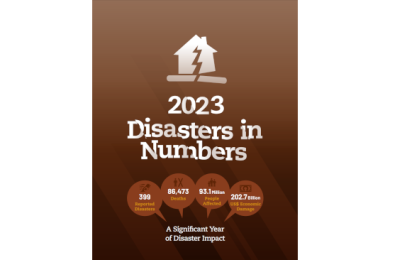The Centre for Research on the Epidemiology of Disasters (CRED) has released its latest report titled "2023 Disasters in Numbers: A Significant Year of Disaster Impact", shedding light on the catastrophic events that unfolded globally last year. The report, drawing from the Emergency Events Database (EM-DAT), reveals a staggering total of 399 disasters linked to natural hazards in 2023. These calamities resulted in 86,473 fatalities and impacted 93.1 million people. Economic losses soared to an estimated US$202.7 billion, underlining the profound socioeconomic repercussions of these events.
One of the most devastating occurrences of 2023 was the earthquake that struck Türkiye and the Syrian Arab Republic in February, claiming 56,683 lives and inflicting US$42.9 billion in damages. This seismic event alone accounted for two-thirds of the total fatalities recorded by EM-DAT for the year.
While the number of individuals affected by disasters in 2023 was lower than the annual average of the preceding two decades, the report emphasizes the heightened mortality rate, surpassing both the 20-year average and the median value. This surge in deaths was primarily attributed to the catastrophic earthquake in Türkiye and Syria. Additionally, the report highlights disparities in reporting economic losses, particularly in Africa, underscoring the urgent need for enhanced global efforts in evaluating, reporting, and disseminating such data.
The publication underscores the ongoing challenges in accurately assessing the full extent of disaster impacts, with some events still unfolding and certain data possibly incomplete. Despite these limitations, the report provides crucial insights into the unprecedented scale of disasters experienced in 2023. As the world grapples with the increasing frequency and severity of natural hazards, the findings of the CRED report serve as a stark reminder of the urgent need for comprehensive disaster preparedness and mitigation strategies on a global scale.
The report can be accessed here.


